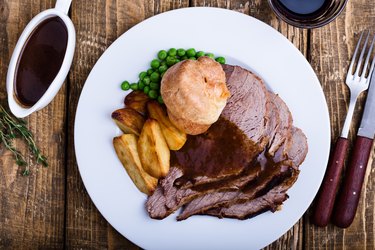
Well known by the name "English roast," other aliases for this beef cut include cross rib roast, Boston cut, beef chuck cross rib pot roast, English cut roast and thick rib roast. Meat eaters will find this cut to be suitable for braising, stewing and slow-cooking methods.
Tip
The English roast cut of meat is from the cow’s shoulder. The beef is typically tough and contains fat, making this cut less expensive than others you find on the market.
Video of the Day
Video of the Day
What’s the Most Tender Roast?
Butchers might use the term English roast to refer to the beef chuck cross rib pot roast cut and boneless version of the same cut. Comparing cross rib roast versus chuck roast, the cross rib roast, or English roast, is often the more tender cut despite its tough and fatty meat from the cow's shoulder. The secret to its tenderness lies in the cooking method and quality of the protein you select, according to the USDA.
To prepare English roast, the following cooking tips can help you create a tender meat worthy of a British Sunday meal entrée:
- Cook the meat low and slow using a pot roasting method. As the
cut originates in the beef shoulder, this area of the cow contains a high muscle
content and connective tissue, creating fairly tough meat. This also means the
outside could likely burn before the interior turns soft. Using a long roasting
method can solve this issue. The slow cooking times and added liquid keep the
meat moist and melt the connective tissue.
- Consider braising the meat. A 4-pound English cut prime rib will take around three hours to braise in an oven
set to 325 degrees Fahrenheit. However, rather than rely on exact timings, the
USDA recommends using a meat thermometer to check when the roast interior
reaches 145 F. The USDA also suggests leaving the meat to rest for a
few minutes after you remove it from the oven. This lets the moisture spread
through the meat, rather than staying concentrated in the center.
- Stew the meat. Stewing keeps English roast moist throughout the cut. Instead of leaving the English roast in one large meat joint, cut it into small cubes, around 1-inch wide. Mixed with onions, carrots, garlic, tomatoes, beef stock, herbs and seasoning, the meat makes a rich, tasty stew. Depending on the amount of meat, the stew can take between one and two hours to cook. According to the USDA, you should allow at least 1/3 pound of shoulder roast per person.
To start cooking, you can try this LIVESTRONG.com recipe for Gremolata Beef Roast and pair it with our Hasselback Carrots as a side dish.
Take Necessary Precautions With Meat
According to the Centers for Disease Control and Prevention, raw meat can spread germs. To avoid spreading any potential bacteria, use a different cutting board for the vegetables you add to any slow cookers or roasting pans that you will use with an English roast. You should also wash your hands for at least 20 seconds when working with raw meat.
As another precaution, be sure to look for the USDA stamp. This tells you that the meat is wholesome and clean for consumption. Most meat used for roasts will contain the label "USDA Select" because the meat isn't tender and contains less marbling, according to the USDA.
In addition, one way to combat potential food poisoning is to stay vigilant on avoiding cross-contamination of meat products. In a February 2018 study from MOJ Proteomics & Bioinformatics, researchers found that food-borne pathogens serve as a major source of illness and death.
- U.S. Department of Agriculture: “How to Buy Beef Roasts”
- Centers for Disease Control and Prevention: “Four Steps (Clean, Separate, Cook, Chill) to Food Safety”
- MOJ Proteomics & Bioinformatics: “Study of Bacterial Contamination of Raw Meat in Hyderabad”
- U.S. Department of Agriculture: "What’s Your Beef – Prime, Choice or Select?"